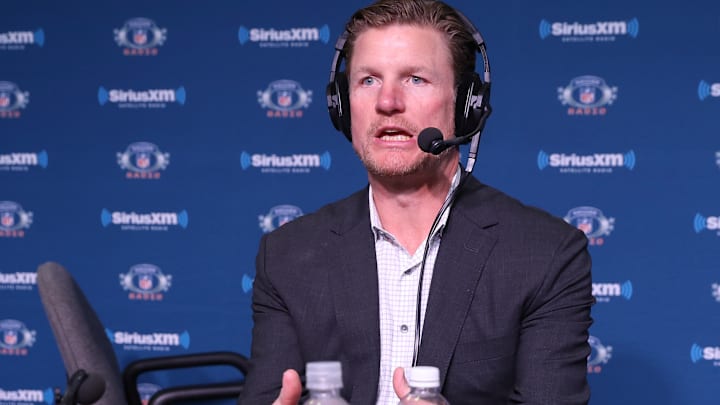There is a curious perception among NFL fans when it comes to trade scenarios, that one man's trash is everyone's trash. And that is simply not the case. If you examine the LA Rams history of trading players, both on and off of the roster, the compensation associated with those players has seldom aligned with the production of that player. All-Pro DB Jalen Ramsey was dealt for a Round 3 pick plus a backup tight end named Hunter Long.
Conversely, the Rams traded for backup RB Sony Michel, and gave up picks in Round 5 and Round 6. At the time, the New England Patriots were rumored to be contemplating releasing Michel outright. So what currency standard was used to value the exchanges in each case?
While we all ponder that question, let's cite an example that everyone can follow. The LA Rams were in hot pursuit of Carolina Panthers DE/OLB Brian Burns in the middle of the 2022 NFL season at the trade deadline. At the time of their offer, the Rams offered a Round 1 pick in the 2024 NFL Draft, plus Round 1 and Round 2 picks in the 2025 NFL Draft to the Panthers, but they declined.
Now, facing an impasse, the Panthers are trading Burns to the New York Giants for far less. The Giants are trading their picks in Rounds 2 and 5 in the 2024 NFL Draft to the Panthers for Burns. So the question is, why such devaluation?
🚨 🚨 🚨
— Ian Rapoport (@RapSheet) March 11, 2024
Trade! The #Panthers are trading star Brian Burns — at last! — to the #Giants, per me and @MikeGarafolo.
Burns lands a 5-year deal worth $150M max with $87.5M guaranteed, done by Todd France of @AthletesFirst.
Carolina sends Burns to NYG for a 2nd and 5th rounders.… pic.twitter.com/UpdtdzB6s6
To create a solid foundation for the rest of this article, let's put Brian Burns production and compensation in a data table, and see if that reveals any clues as to why Burns trade value dropped so precipitously:
Year | Games | Snaps | Tackles | Sacks | QB hits | Pressures | Salary cap |
|---|---|---|---|---|---|---|---|
2019 | 16 | 477 | 25 | 7.5 | 16 | 23 | $2.46 M |
2020 | 15 | 750 | 58 | 9.0 | 21 | 37 | $3.08 M |
2021 | 17 | 840 | 50 | 9.0 | 18 | 31 | $3.69 M |
2022 | 16 | 951 | 63 | 12.5 | 22 | 30 | $4.31 M |
2023 | 16 | 814 | 50 | 8.0 | 18 | 21 | $16.01 M |
Now that we have the data, how shrewd can we be in detecting patterns for his devaluation? Lets focus on three different categories:
Production
While Burns production did regress in 2023 from his 2022 peak, that does not explain the drop in his value. His number of tackles in 2023 and 2021 fall in the same category, and his number of quarterback sacks falls in his range. Trends are better indicators than single seasons, and Burns continues to remain among the best NFL pass rushers each season.
Duration
Here is where there is a rather significant change. In 2022, Burns was playing in the fourth season under his rookie contract, and his value was optimal. A 12.5 quarterback sack production from a player earning just $4.3 million in the NFL is incredible value. And the team that trades for Burns has the option to extend him for a fifth season.
The Rams had 1.5 seasons with Burns before any extension decision had to be made.
The LA Rams were trading for the second half of year four, and the option to extend him for a fifth year. But that is not what the New York Giants were trading for. By the time they entered negotiations, Burns had been assigned the franchise tag by the Panthers, which would last only one season. Those additional options on Burns' contract hold extra value. But there is a third category in this analysis, and that is:
Compensation
When the LA Rams weighed into the trade negotiations for Brian Burns, he was earning jus $4.3 million. That bargain basement price commands a premium. After all, the team gets to trial the player at a below market price and collect plenty of first-hand information about fit, attitude, and coachability during that time.
The Giants, with their current contract extension with Burns, Yes, they will have the same opportunity to discover all these things, but will do so after commiting to a five year, $141 million contract. Complicating matters even more, $87.5 million is guaranteed of which $76.5 million is fully guaranteed at signing.
When the LA Rams traded for Denver Broncos All-Pro OLB Von Miller, they agreed to give the Broncos a Round 2 pick in the 2022 NFL Draft for Miller, and a Round 3 pick in the 2023 NFL Draft as compensation for the Broncos holding the bag on Von Millier's remaining $9 million due for his 2021 NFL compensation. In the end, the Rams paid Von Miller just over $762,000 to play for them in 2021.
So there is a definable value in trading for players based on how much that player will impact the salary cap.
Now we have the information that connects the dots. The Rams were taking on no salary cap risk in trading for Brian Burns in 2022. But the Giants are taking on a huge financial risk if Burns fails to perform at his compensation level.
Now we all have necessary information with which to assess trade scenarios. It's not just about production, after all.
As always, thank you for reading.
